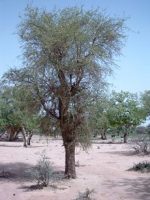 Egyptian balsam is a shrub or small tree native to much of Africa and parts of the the Middle East where it grows in arid and sub-arid tropics and subtropics including savannas, deciduous bushlands, along watercourses , in woodlands, and on seasonally inundated plains. It is also known by many common names including desert date, soap berry tree, thron tree, Jericho balsam, and simple thorned torchwood, and is a member of the caltrop family, Zygophyllaceae, that also includes the creosote bush (Larrea tridentata). The plant grows up to 33′ tall and has a fluted trunk with grayish-brown fissured bark that sheds to reveal yellow-green patches. The many branches bear long, straight, spirally arranged, green spines that give rise at their base to dark green, leathery, compound leaves with two leaflets. The plant is evergreen when conditions are humid but usually sheds its leaves when moisture is lacking. During the dry season tiny greenish-yellow flowers with 5 petals appear in clusters, either sessile or on short stalks, and produce an ellipsoid green fruit that is 1.6″ long, ripens to brown or tan, and has a brittle skin, brown-green sticky pulp, and a hard center stone. The plants are very tolerant of a wide variety of soil types from sand to heavy clay, moist to dry and relatively tolerant of flooding, livestock activity, and wildfire. The fruits, leaves, flowers and branches are highly valued in Africa for subsistence living food, medicinal products, and fuel-wood. The thorns are used for tattooing and the thorny nature of the plant makes it good choice for hedges. The genus name Balanites, is from the Greek word balanitēs meaning acorn-shaped and refers to the fruit. The specific epithet, aegyptiaca, is the Latinized form of Egypt, and refers to the place where the first specimen plants were found and described.
Egyptian balsam is a shrub or small tree native to much of Africa and parts of the the Middle East where it grows in arid and sub-arid tropics and subtropics including savannas, deciduous bushlands, along watercourses , in woodlands, and on seasonally inundated plains. It is also known by many common names including desert date, soap berry tree, thron tree, Jericho balsam, and simple thorned torchwood, and is a member of the caltrop family, Zygophyllaceae, that also includes the creosote bush (Larrea tridentata). The plant grows up to 33′ tall and has a fluted trunk with grayish-brown fissured bark that sheds to reveal yellow-green patches. The many branches bear long, straight, spirally arranged, green spines that give rise at their base to dark green, leathery, compound leaves with two leaflets. The plant is evergreen when conditions are humid but usually sheds its leaves when moisture is lacking. During the dry season tiny greenish-yellow flowers with 5 petals appear in clusters, either sessile or on short stalks, and produce an ellipsoid green fruit that is 1.6″ long, ripens to brown or tan, and has a brittle skin, brown-green sticky pulp, and a hard center stone. The plants are very tolerant of a wide variety of soil types from sand to heavy clay, moist to dry and relatively tolerant of flooding, livestock activity, and wildfire. The fruits, leaves, flowers and branches are highly valued in Africa for subsistence living food, medicinal products, and fuel-wood. The thorns are used for tattooing and the thorny nature of the plant makes it good choice for hedges. The genus name Balanites, is from the Greek word balanitēs meaning acorn-shaped and refers to the fruit. The specific epithet, aegyptiaca, is the Latinized form of Egypt, and refers to the place where the first specimen plants were found and described.
Type: Semi evergreen shrub or small tree
Outstanding Feature:
Form: Spherical crown
Growth Rate: Slow
Bloom: Clusters of tiny greenish yellow flowers during the dry season
Size: 33′ H
Light: Full sun
Soil: Sand to clay, moist to dry; very tolerant of varying soil moisture conditions but does not like humid climate.
Hardiness: Zones 10-13
Care: Low maintenance
Pests and Diseases: Locusts, beetles, leaf galls, scale, borers, Bunaea alcinoe, Phoma balanies, Septoria balanitis
Propagation: Seed, division
Outstanding Selections: Not relevant
Photo Credit:Wikipedia